When it comes to choosing between an eSIM and a SIM, overall, an eSIM offers more convenience and flexibility than a physical SIM. It eliminates the hassle of swapping out a physical SIM card, and offers more convenience when it comes to things like topping up data. Let’s take a closer look at each option.
So you’re exploring your options for using data and keeping flexible with your smartphone, but you’ve become overwhelmed by choices. You might be a little confused about whether to choose an eSIM or a traditional, physical SIM card. Sound accurate?
Well, consider this your go-to guide to break down their key differences, compare the technical details, and best use cases.
Here are a few factors to consider for any scenario, whether you’re travelling, switching phone providers, or just exploring options for the future.
What is a SIM card?
First up: a SIM card, or “Subscriber Identity Module,” is likely the component you already know. Essentially, this tiny tech is a small physical chip that gets inserted into your phone via a slot or drawer to connect it to a mobile network.
Your SIM stores all pertinent data, like your phone number, carrier information, and authentication keys. The size of SIM cards can be slightly variable—standard, micro, and nano—though they’re all quite little, as well as are removable, meaning you can usually swap them between devices.
What is an eSIM?
Next: an eSIM, or “embedded SIM,” is basically a digital version of a SIM card. It is built directly into your phone’s hardware. As you might have guessed, instead of inserting a physical chip, you can activate an eSIM by simply downloading a carrier profile onto your smartphone or device.
An eSIM means you can switch between networks or even add new plans without needing a new SIM card.
Key differences: eSIM versus SIM
Perhaps the biggest, and most obvious, difference between a physical SIM and an eSIM is in the installation. A physical SIM card requires manual removal and insertion. On the other hand, an eSIM can conveniently be integrated into your phone and activated remotely.
This means that switching between two (or more) carriers is also easier with an eSIM because there’s no need to wait for a new physical SIM card to be shipped to your home or have to visit a store to purchase one. You can just download a new data plan digitally (from the aloSIM website or app).
If you’re a frequent traveller, an eSIM offers a much easier way to stay connected. Instead of wasting time hunting for a local SIM card from a store at your destination, you can easily buy and activate an eSIM online before you leave home.
aloSIM in particular makes this process seamless, and allows you access to local data without switching your primary number.
Bonus: From a security standpoint, an eSIM is exceptionally safer. With an eSIM, there is no risk of it being lost or stolen, unlike a traditional SIM card. Just note that not all devices and carriers support eSIM technology yet, so compatibility might be your deciding factor.
Which one is right for you?
If your phone supports eSIM, then it’s a great option for convenience, flexibility, and security. You can get started with aloSIM right away to find the perfect data package. aloSIM offers data plans in 200+ countries, with a range of different sized package that will work for your needs.
If you have an older phone or your device doesn’t support eSIM, then a physical SIM remains a reliable choice.





